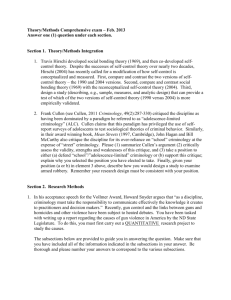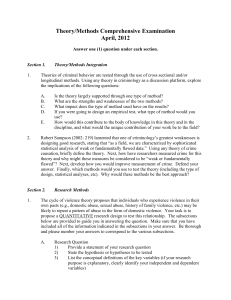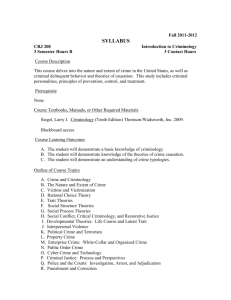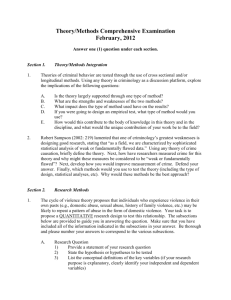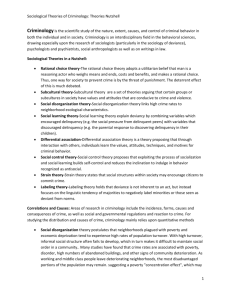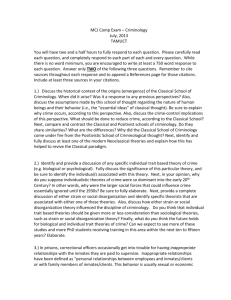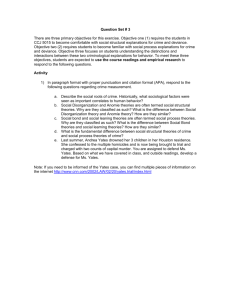Final Exam
advertisement
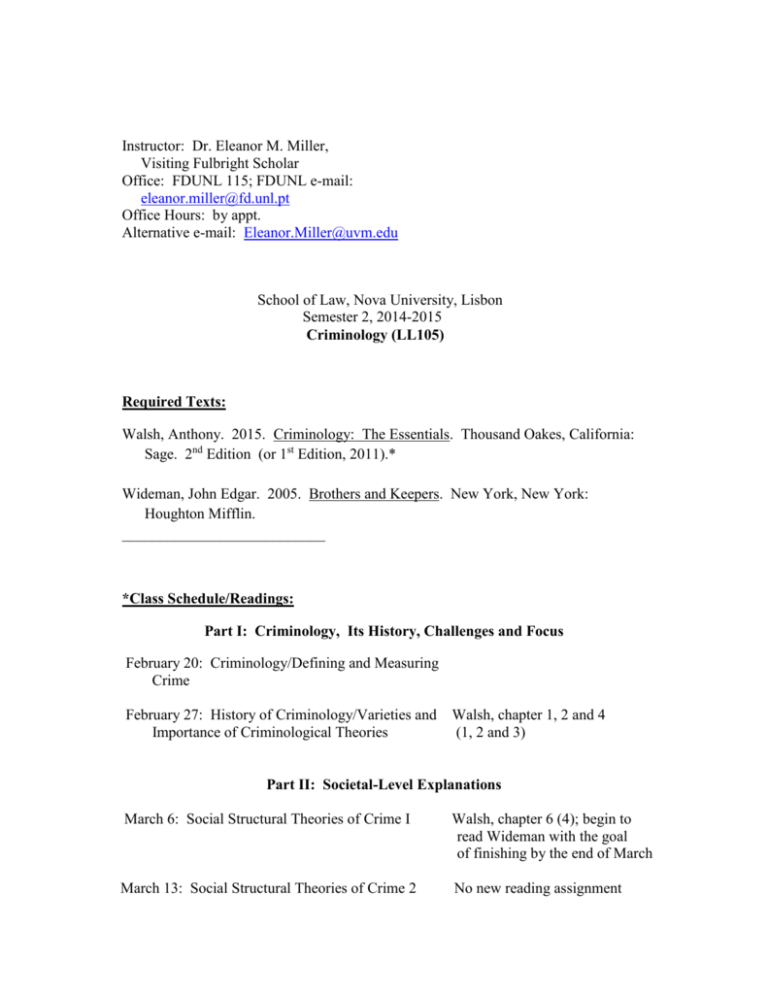
Instructor: Dr. Eleanor M. Miller, Visiting Fulbright Scholar Office: FDUNL 115; FDUNL e-mail: eleanor.miller@fd.unl.pt Office Hours: by appt. Alternative e-mail: Eleanor.Miller@uvm.edu School of Law, Nova University, Lisbon Semester 2, 2014-2015 Criminology (LL105) Required Texts: Walsh, Anthony. 2015. Criminology: The Essentials. Thousand Oakes, California: Sage. 2nd Edition (or 1st Edition, 2011).* Wideman, John Edgar. 2005. Brothers and Keepers. New York, New York: Houghton Mifflin. ___________________________ *Class Schedule/Readings: Part I: Criminology, Its History, Challenges and Focus February 20: Criminology/Defining and Measuring Crime February 27: History of Criminology/Varieties and Importance of Criminological Theories Walsh, chapter 1, 2 and 4 (1, 2 and 3) Part II: Societal-Level Explanations March 6: Social Structural Theories of Crime I Walsh, chapter 6 (4); begin to read Wideman with the goal of finishing by the end of March March 13: Social Structural Theories of Crime 2 No new reading assignment March 20: Social Process Theories of Crime March 27: Critical and Feminist Theories of Crime Walsh, chapter 7 (5) Walsh, chapter 8 (6) Part III: Individual-Level Explanations April 10: Crime as Choice: Rational Choice and Anarchist Criminology Walsh, chapter 5 Available in FDUNL Library Wideman papers are due at the beginning of the first half of this class April 17: Psychosocial and Biosocial Theories of Of Crime Walsh, chapter 9 and 10 (7 and 8) April 24: Developmental Theories of Crime Walsh, chapter 11 (9) Part IV: Criminal Acts May 8: Crimes of Violence and Terrorism Walsh, chapters 12 and 13 (10 and 11) May 15: Public Order Crimes Walsh, chapter 15 (13) May 22: Property Crimes and White-Collar Crimes Walsh, chapters 14 and 16 (12 and 14) *The chapters in the first edition are given in parentheses Course Learning Objectives and Perspective This course is divided into four parts. The goal of Part I is to learn about the history of criminology, early criminological theories, problems defining and counting crime and criminals, sources of crime data in the U.S., and a bit about the extent and nature of crime in that country. Part II is designed to introduce the major social theories criminologists use to explain crime and frame their research, and evaluate empirical evidence that reveals the relative merits of these theories. In a parallel way, Part III looks at individual-level theories. Finally, part IV is an introduction to acts that are regarded as criminal, their characteristics and the characteristics of those who commit them. By the conclusion of this course, students should have a good grasp of the major explanations criminologists have advanced to understand crime and the criminal and some familiarity with the character of the crime problem in the U.S. The perspective taken in this sociology course is a critical one. It assumes that there is a complicated, but clear, relationship between how a society is organized and how resources and power are distributed and the patterns of crime that characterize it. This perspective assumes as well that social inequality in all its manifestations is a major factor in accounting for the distribution of crime and victimization within a society and for societal responses, including criminal justice responses, to particular sorts of crime, criminals and victims. Assessment of Student Learning Wideman-based Criminological Theory Paper Assignment In the book, Brothers and Keepers, John Edgar Wideman describes his own attempt to understand how and/or why he turned out to be a “law-abiding” citizen of some achievement, while his brother, Robbie, ends up with a conviction for murder and a life sentence. In doing so, he utilizes and highlights different aspects of many of the sociological theories that we have discussed in this course. In a typed, double-spaced essay of 7-8 pages with standard margins, you should choose two of the sociological theories we have discussed and use them to analyze Robbie’s path to prison versus John’s path to a professorship. You should choose from the following list of theories: 1) Merton’s Anomie (Strain) Theory 2) Cloward and Ohlin’s Theory of Differential Opportunity 3) Cohen’s Theory of Delinquent Subcultures 4). Sutherland’s Theory of Differential Association 5) Matza’s Theory of Delinquency and Drift (including his ideas of the positive delinquent and the subculture of delinquency) 6) Hirschi’s Social Control Theory 7) Labeling Theory Assignment Instructions 1) Begin by summarizing each theory. Make sure that you explain what “causes” someone to become a criminal according to this particular theory. You also should make sure that you address both the basic assumptions and key concepts of the theory. In other words, give a complete and thorough summary of each of the two theories in your own words that shows that you understand them (20 points). 2) Use each theory to explain the theme of the book: one brother becomes a criminal and the other does not. Use concrete examples from the book to illustrate how the theory explains the situations discussed and to illustrate the key concepts of the theory (20 points). 3) Finally, assess the adequacy of each theory as an explanatory frame. Why is either adequate or not. Does one offer a better explanation than the other (10 points)? Your grade for this assignment will not be determined by the length of your paper. However, I seriously doubt that you can do a good job in fewer than 7 pages. Papers are due at the beginning of the first half of class on April 10th. Late papers will not be accepted. This assignment is worth 30% of the course grade. Final Exam The final exam will be given in accord with the rules governing these exams in effect at FDUNL. The exam date/time will be changed from that published by FDUNL. It will be scheduled sometime before the last week in June. As soon as I have arranged for the exam to be rescheduled, I will announce this information in class and publish it on the course website. The final exam is worth 70% of the course grade. Professor Miller will conduct a review of the course material prior to the examination on a date and at a time and place to be announced. Cheating Plagiarism or cheating of any kind will not be looked upon kindly by this instructor and will be brought to the attention of the appropriate FDUNL authorities. Attendance Every class meeting is very important. Attendance and participation in class is expected, and I can almost guarantee that you will not do well in this class if you do not attend regularly. Reading There is quite a bit of reading for this course and much of it is fairly difficult. Some weeks are heavier than others, so try to plan ahead. I would suggest the following: 1. Summarize what you’ve read in your own words. If you can’t put what you’ve just read in your own words (for example, try explaining it to a friend), then you probably don’t understand it. Try doing this for each excerpt, article or chapter of a book. What’s the author trying to say? 2. Write down things you don’t understand – words, phrases, historical events, names, etc. that are unfamiliar or unclear. Bring these up in class or discussion section. The chances are almost 100% that if you have questions, so do others. But if each person in class is afraid to admit they don’t understand, then no one will ever know. If you think you’re the only one “stupid” enough to be puzzled, you’re probably wrong. And when an entire room of people is doing the same thing, all self-conscious and embarrassed, then learning doesn’t go on. The point is to learn from each other, break down these barriers, and be less competitive. 3. Write down things you disagree with. Most of the books and articles have a point of view. Sometimes it will be obvious and smack you in the face. Other times, it will be more subtle. If you think something is wrong, misleading or “biased,” say so, and try to explain why you think so. It is difficult to have an open, freewheeling discussion in a class this size, but we will try. If you write down the things you disagree with before class, that will save time and effort. 4. Write down things that delight you or make your stomach roil. Try to figure out why you have the gut reaction you have. Try to connect your gut and your head.

